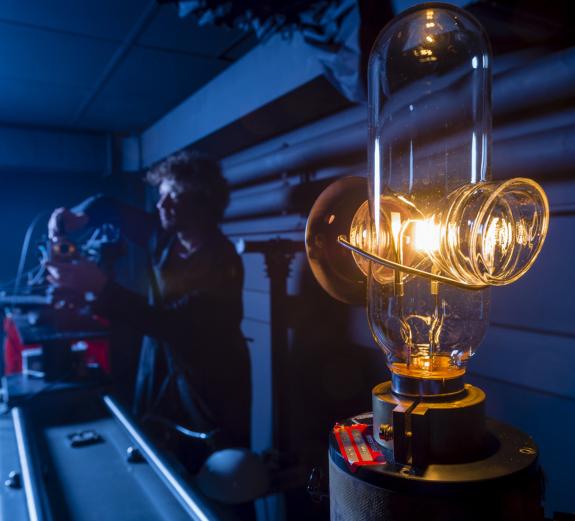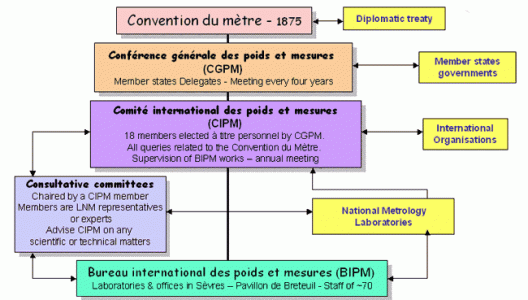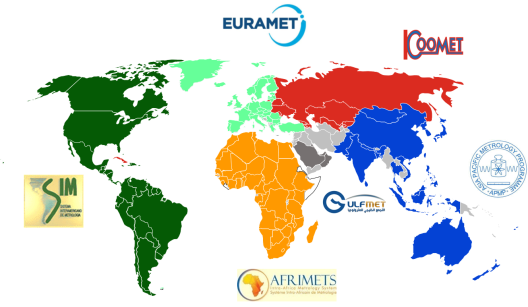
Since the French Revolution, and the development of the decimal metric system, metrology has developed strongly throughout the world. The guarantee of reliable and recognized measurements, the evolution of technologies, imply having authorities at the highest level that examine and propose solutions in the field of measurement. How is metrology organized at the international level? Which bodies are responsible for defining units and developing measurement standards? Here are some answers.
The Meter Convention
The Metre Convention, a diplomatic treaty, was signed on 20 May 1875 by 17 member states. The purpose of this convention is to promote the decimal metric system. Following this convention, a scientific bureau, the Bureau International des Poids et Mesures (BIPM), was created.
As of 20 May 2019, the number of member states is of 60 countries, including 29 countries on the European continent.
In order to facilitate the integration of new States, in particular for participation in the CIPM MRA, countries are associated with the General Conference on Weights and Measures (CGPM). These countries have no voting rights in the CGPM. As of 7 August 2018, 42 States or economies have signed the association with the CGPM.
It should be noted that the President of the CIPM, the Vice-President of the CIPM, the Secretary of the CIPM and the Director of the BIPM must be of different nationalities.
It is the desire to work together for the advancement of science that leads Member States to join the Metre Convention, not only in their own interest, but also in recognition of the necessity for all countries to participate in a work of global progress from which they too will benefit.
The General Conference on Weights and Measures (CGPM)
The CGPM, a diplomatic conference which brings together the delegates of the Member States of the Metre Convention, meets at least once every six years at the invitation of the French Ministry of Foreign Affairs. Currently, and since 1960, meetings of the CGPM are held approximately every four years.
The opening session is chaired by the French Minister of Foreign Affairs and the working sessions by the President of the Paris Academy of Sciences.
Missions of the CGPM
- to elect the members of the CIPM;
- discuss and decide on the necessary measures to ensure the extension and improvement of the implementation of the International System of Units, the SI ;
- validate the results of new fundamental metrological determinations and adopt the various scientific resolutions of international scope;
- adopt important decisions concerning the functioning and development of the BIPM.
The International Committee for Weights and Measures (CIPM)
The CIPM meets at least once a year. It is composed of eighteen eminent personalities, scientists and metrologists of different nationalities, elected in their personal capacity by the CGPM. France, holder of the diplomatic treaty, de facto has a seat on the CIPM.
Missions of the CIPM
- prepare proposals and recommendations to be submitted to the CGPM ;
- supervise and direct the work of the BIPM;
- to prepare an annual report on the financial and administrative situation of the BIPM.
In view of the ever increasing number of new Member States, and as a result of new and numerous scientific and technical works developed by the National Metrology Institutes (NMIs), the CIPM has, since 1927, set up a series of Consultative Committees (CCs) to study in greater depth scientific and technical progress that may have a strong influence on metrology.
The Consultative Committees (CCs)
The Consultative Committees are composed of international experts and specialists from the National Metrology Institutes. The CCs are usually chaired by a member of the CIPM.
Missions of the CCs
- to study the work and the scientific and technical progress which are being made, and to analyse the consequences which this work may have in metrology;
- prepare recommendations to be discussed by the CIPM and presented to the CGPM;
- organize international comparisons of measurement standards and review their results;
- to make recommendations on the work that could be carried out by the BIPM.
Ten CCs have been created up to this day:
- CCEM (1927) : Electricity - Magnetism
- CCPR (1933) : Photometry - Radiometry
- CCT (1937) : Temperature
- CCL (1952) : Length
- CCTF (1956) : Time - Frequencies
- CCRI (1958) : Ionizing Radiation
- CCU (1964) : Units
- CCM (1980) : Mass
- CCQM (1993) : Amount of substance
- CCAUV (1998) : Acoustics - Ultrasound - Vibration
The International Bureau of Weights and Measures (BIPM)
The BIPM, located at the Pavillon de Breteuil in Sèvres (France), is a scientific metrology laboratory whose essential mission is to ensure uniformity of measurements throughout the world (both physical and chemical). The Director of the BIPM is appointed by the CGPM.
The BIPM carries out fundamental research to improve reference standards in collaboration with the National Institutes of Metrology (NMIs), to participate in and organize international comparisons, and to maintain the reference standards for which it is responsible.
The operation of the BIPM is ensured by the contributions paid by each Member State participating in the Metre Convention. The annual allocation to the BIPM, as defined in the CGPM, is distributed among States according to a scale based on the coefficients of the United Nations scale, but with maximum limits of 10% and minimum limits of 0.5% of the total allocation.
All States contributing to the maintenance of the BIPM are co-owners of its facilities.
Regional Metrology Organizations (RMOs)
Several factors have led to the creation of regional metrology organizations (RMOs):
- A significant number of countries, which have acceded to the Metre Convention since its creation, still growing, thus complexifying the organization;
- closer exchanges between countries in the same region;
- a strong desire for scientific cooperation;
- a request for the organization of "less official" comparisons than under the CIPM for emerging countries, some of which are not members of the Metre Convention;
- a strong demand for accessibility to metrological services.
A generic term refers to the national body in charge of scientific and technical metrology in each country: National Institute of Metrology (NMI). Depending on its structure and organisation, each country may be composed of several national metrology laboratory, one NMI (in France, LNE) and designated laboratories, the DIs (in France, LNE-LNHB, LNE-LCM, LNE-SYRTE, LNE-CETIAT, LNE-ENSAM, LNE-IRSN, LNE-LADG, LNE-LTFB, LNE-Trapil).
The first RMOs were created in the 1970s and 1980s:
- EURAMET : European Association of National Metrology Institutes, currently includes members from 39 countries (Europe region).
- APMP: Asia and Pacific Metrology Programme, includes members from 28 economies (Asia - Pacific region).
- SIM : Sistema Interamericano de Metrologia, includes members from 33 countries (Americas region)
- AFRIMETS : Intra-African Metrology System, includes members from 48 countries (Africa Region)
- COOMET : Euro-Asian Co-operation of National Metrology Institutes, includes members from 17 countries (Eastern Europe and Cuba region)
- GULFMET : Gulf Association for Metrology, includes members from 6 countries (Gulf region)
The active members in these regional organizations are the NMIs and DIs of the countries that have joined the organization. Associate members are also accepted by RMOs, or corresponding members, especially for countries that are in areas where no regional organization has yet been established.
To date, RMOs have grown exponentially, and their role in the international metrology scene has undoubtedly increased. RMOs play an essential role in the implementation of the Metre Convention.
The Mutual Recognition Arrangement: the CIPM MRA
The Mutual Recognition Arrangement (MRA) was drafted by the International Committee for Weights and Measures (CIPM) under the authority conferred upon it by the Member States of the Metre Convention, and signed in October 1999 by the directors of the NMIs.
The CIPM MRA establishes mutual recognition of national measurement standards and calibration and measurement certificates (Calibration Measurement Capabilities - CMCs) issued by their laboratories.
To establish the criteria for mutual recognition on an objective basis, this arrangement is based on:
- the results of a set of key comparisons carried out according to specified procedures which lead to a quantitative estimate of the degree of equivalence of national measurement standards ;
- the implementation by each NMI or DI of appropriate means to ensure the quality of measurements;
- the effective participation of each NMI or DI in appropriate supplementary comparisons.
This arrangement consists of two parts: in the first part, the Parties recognize the degree of equivalence of the national measurement standards of the participating laboratories; in the second part, the Parties recognize the validity of the calibration and measurement certificates issued by the participating laboratories. A specific logo has been created, which can be applied to calibration certificates issued by NMIs or DIs, for CMCs published in the KCDB (BIPM Key Comparison DataBase).
Key points of the MRA
Objectives
- establish the degree of equivalence of national measurement standards maintained by the NMI or DI;
- provide for the mutual recognition of calibration and measurement certificates issued by NMIs or DIs;
- provide governments and other parties with a sound technical basis for broader agreements related to international trade, business and regulatory activities.
Methods used
- international measurement comparisons, designated key comparisons ;
- international comparisons of additional measurements;
- implementation by NMIs and DIs of quality management systems and demonstration of their skills ;
- assessment of the calibration capabilities of all NMIs and DIs. This evaluation is done first within each RMO, then by the other RMOs and validated by the JCRB, the joint RMO and BIPM committee.
Result
- statements of measurement capability for each laboratory, recorded in a database managed by the BIPM and accessible to the public via the web.
Commitment
The directors of the NMIs that sign the MRA do so with the approval of the appropriate authorities in their country. By the same token, they:
- accept the procedures set out in the Arrangement to establish the database;
- recognize the results of key and supplementary comparisons entered in the database;
- recognize the calibration and measurement capabilities of the other laboratories participating in the arrangement and listed in the BIPM database.
Organization
- overall coordination is carried out by the BIPM under the auspices of the CIPM;
- the CIPM Consultative Committees, the Regional Metrology Organizations (RMOs) and the BIPM are responsible for the organization and conduct of key and supplementary comparisons and for the validation of their results;
- a Joint Committee of the Regional Metrology Organizations and the BIPM (JCRB) is responsible for examining the possibilities for measurements and calibrations declared by the NMIs and DIs for inclusion in the BIPM database.
A database containing the results of key comparisons of national measurement standards and lists of calibration and measurement capabilities of NMIs is available on the BIPM website, the KCDB (BIPM Key Comparison DataBase).
Other international organizations
Organisation internationale de métrologie légale (OIML)
OIML (Organisme International de Métrologie Légale) is an intergovernmental organization created in 1955 whose general objective is the coordination and harmonization at the international level of administrative and technical regulations on measures and instruments of measures promulgated by the various countries. OIML has 62 Member States and about 65 corresponding members. OIML is recognized as an international standardization body by the World Trade Organization.
The aim of this harmonisation is to facilitate trade between countries not only in measuring instruments but also in all operations involving measurements. To this end, the OIML draws up international recommendations.
The OIML operates with a permanent office located in Paris and called the Bureau International de Métrologie Légale (BIML). This office centralizes the work carried out by the technical offices in the member countries and coordinates all OIML activities.
OIML Committees
- The International Conference on Legal Metrology, with diplomatic status. This conference, which brings together the Member States every four years, is responsible for taking fundamental decisions concerning the OIML, in particular its budget, its working policy and the formal adoption of the International Recommendations;
- The International Committee for Legal Metrology (CIML) follows the technical work and approves the recommendations before their adoption by the International Conference. These recommendations were developed by the Technical Working Groups. CIML members are responsible for the national legal metrology services of OIML Member States. The CIML elects a President from among its members;
- The Presidency Council, a group convened by the President of the CIML, whose mission is to assist the latter in strategic reflections on the development of the OIML
The official languages of the OIML are French and English.
BIML publishes a specialized journal: "Le Bulletin de l'Organisation Internationale de Métrologie Légale".
IMEKO (International Measurement Confederation)
IMEKO was founded in 1958. It is a federation of metrology societies and universities that feel concerned by all types of measures (scientific, technological and/or industrial).
Currently IMEKO has 42 member organisations (for 42 countries). IMEKO's objective is to:
- promote exchanges on scientific and technological information in the field of measures;
- facilitate cooperation between scientists;
- organising international conferences, including the IMEKO World Congress, which takes place every three years, and thematic conferences such as Flowmeko, Tempmeko, etc.
In order to cover as widely as possible the problems related to measurements that can be carried out in laboratories, IMEKO has organized itself into technical committees: TCs. At present 24 TCs have been created.
The Collège Français de Métrologie (CFM) is the French member of IMEKO, and as such participates in the General Council. The CFM also has representatives on some of the IMEKO technical committees.
The 24 technical committees are as follows:
- TC1 - Education and Training in Measurement and Instrumentation
- TC2 - Photonics
- TC3 - Measurement of Force, Mass, Torque and Density
- TC4 - Measurement of Electrical Quantities
- TC5 - Hardness Measurement
- TC6 - Vocabulary Committee (activité suspendue pour l'instant)
- TC7 - Measurement Science
- TC8 - Traceability in Metrology
- TC9 - Flow Measurement
- TC10 - Technical Diagnostics
- TC11 - Metrological Infrastructures
- TC12 - Temperature and Thermal Measurements
- TC13 - Measurements in Biology and Medicine
- TC14 - Measurement of Geometrical Quantities
- TC15 - Experimental Mechanics
- TC16 - Pressure and Vacuum Measurement
- TC17 - Measurement in Robotics
- TC18 - Measurement of Human Functions
- TC19 - Environmental Measurements
- TC20 - Measurement Techniques for the Construction Industry
- TC21 - Mathematical Tools for Measurements
- TC22 - Vibration measurement and acceleration
- TC23 - Metrology in Food and Nutrition
- TC24 - Chemical measurements

